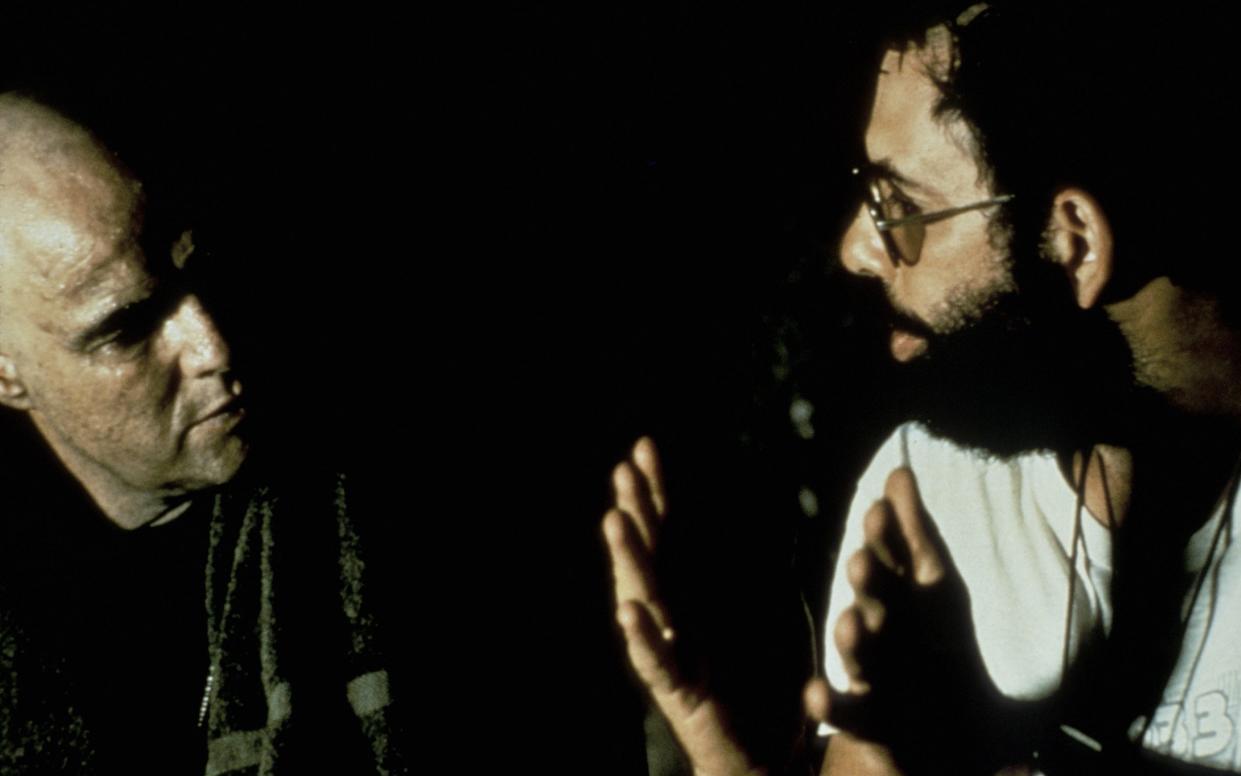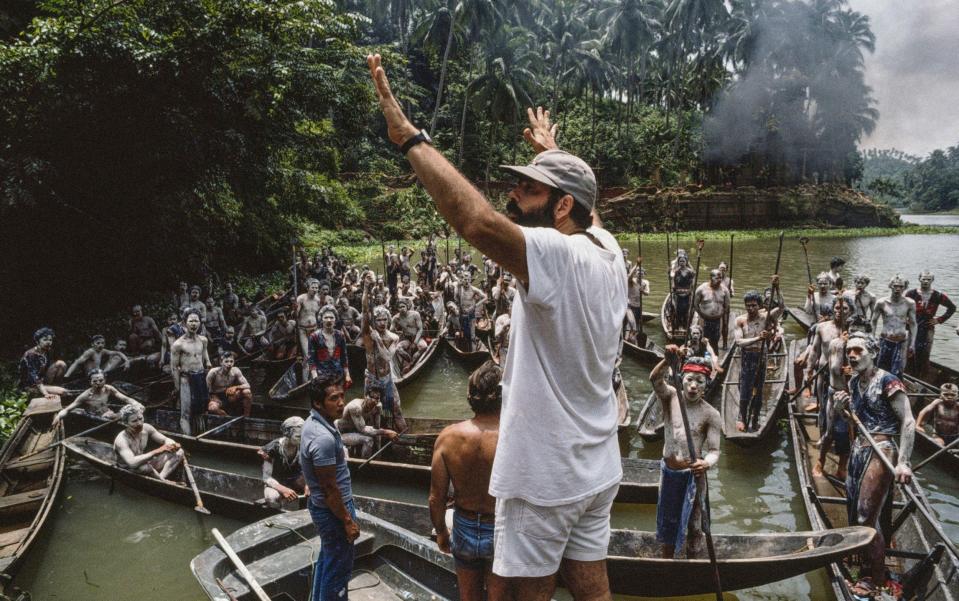‘The work of a madman’: why Coppola’s ‘orgiastic’ $120m epic has Hollywood baffled

- Oops!Something went wrong.Please try again later.
- Oops!Something went wrong.Please try again later.
- Oops!Something went wrong.Please try again later.
- Oops!Something went wrong.Please try again later.
While perusing the Hollywood trade press this week, Francis Ford Coppola could be forgiven a shudder of déjà vu. Exactly 45 years ago, the Godfather director was about to premiere his latest film: a 135-minute state-of-humanity epic he’d been stewing over for years.
Reports of bamboozled preview audiences and an unmanageably chaotic shoot had led many to peg it as a flop-in-waiting that would expose its maker as a spent creative force. But it had also been selected for a competition slot at Cannes – where, in just a few weeks, on the biggest stage in world cinema, this mad magnum opus would either be vindicated or jeered.
In 1979, the film was Apocalypse Now – which, almost half a century on from its bumpy arrival, is revered as one of the greatest war movies ever made. Its 2024 successor, meanwhile, is Megalopolis – a science-fiction parable described as “Blade Runner meets Julius Caesar”, which Coppola, now 85, has been sweating over since the 1980s.
Set in an alternate future version of New York called New Rome, it appears to be largely about town planning, with a visionary architect called Caesar (played by Adam Driver) and a scheming mayor, Cicero (Giancarlo Esposito), at loggerheads over the city’s future shape. But there’s romance too, between Caesar and Julia (Nathalie Emmanuel), the mayor’s celebutante daughter, while parallels with the fall of Rome are reportedly woven through its story of a modern-day empire on the brink of collapse. (Another Roman reference: the male characters’ severe haircuts.)
It cost $120 million, but was entirely self-financed, with funds drawn from the proceeds of the Californian winery Coppola bought with the profits from the first two Godfather films. It is Coppola’s grandest project by some distance since Bram Stoker’s Dracula in 1992, and reportedly combines old-fashioned spectacle with philosophical musings on humankind’s capacity for reshaping our world in the teeth of existential threat. It could be a masterpiece. It could be a fiasco. And history tells us that when it comes to Coppola, these two categories are not mutually exclusive.
Excitingly, the picture became no clearer after the first screening of the finished film, which took place two weeks ago in Los Angeles in front of an invited audience of studio executives. (The film has also since quietly screened in London, though your critic’s invitation must have been lost in the post.) The old guard – Universal, Warner Bros, Disney, Sony and Paramount – were all represented at the highest level, as were the tech-led upstarts Amazon and Netflix. Coppola’s plan was to secure a distribution deal before his Cannes premiere was announced this week. Ideally, he wanted to market the film as a highbrow blockbuster à la Oppenheimer; a treat for mainstream audiences as well as a prestige pick-up.
But that is not how things panned out. A piece in the Hollywood Reporter this week described the “conspicuous silence” in the Imax auditorium afterwards, and noted that no bids for the rights had yet been made. One attendee described the film as less of a conventional studio release than “some kind of indie experiment.” Another less measuredly called it a sad end to Coppola’s career (“the work of a madman”), and warned that any marketing spend would never be clawed back.
“There is just no way to position this movie,” said a third – referring to the two-pronged task of working out who a film’s target audience is, then how to sell it to them. Others still aired misgivings over its go-for-broke nerve: there was much fretting about a sequence in which the actor Jon Voight, 85, is seen in bed in what initially appears to be a state of visible sexual excitement.
Indeed, its attitude towards sex and drugs generally sounds very 1970s, with supporting stars Aubrey Plaza and (an apparently excellent) Shia LaBeouf reportedly sharing a memorable sex scene as part of a broader “orgiastic” sequence bubbling with nudity and substance abuse. Meanwhile, the Puck newsletter reported that the ending involving Voight and Plaza’s characters was “one of the most baffling” two of their moles had ever seen.

Additionally – and it’s not remotely clear if this was a one-off, or if Coppola intends it to become a recurring meme-able moment – there was audience participation too. An attendee quoted by the blog Hollywood Elsewhere described how at one point during the film, the house lights came up and an actor planted in the audience shouted a question at Driver’s character on screen, who then responded as if he could hear him. As theatrical gimmicks go, it’s not quite Barbie’s candyfloss-flavoured Tango Ice Blast.
Suspicions that Megalopolis might turn out to be a Megaflopolis have been brewing for a while, and were first openly aired last year after reports of tumult on set. These were prompted by the abrupt departure of the visual effects team five weeks into the shoot, though Coppola later claimed this was due to budgetary concerns rather than creative differences. (The film was made using the virtual production techniques pioneered by the Star Wars series The Mandalorian, in which scenes are shot inside a sort of LCD-lined bubble that mimics outdoor environments on the fly, rather than against conventional green screens.)

Driver also went on the record to downplay the rumours of havoc. “I’ve been on sets that were chaotic and this one is far from it,” the actor said. But Megalopolis’s lengthy route to the screen has involved more than its fair share of false starts and handbrake turns. In 2001, after having tinkered with the script for almost two decades, Coppola finally got behind a camera, as he and the acclaimed cinematographer Ron Fricke shot around 30 hours of scene-setting footage of contemporary New York on the move. But after the September 11 attacks, Coppola scrapped every frame of it, despairing that his original utopian vision for the piece no longer rang true – and then broke ground on yet another rewrite.
Meanwhile, his films after Dracula – the Robin Williams comedy Jack; the John Grisham adaptation The Rainmaker; three little-seen experimental pieces, Youth Without Youth, Tetro and Twixt – felt like the work of a director whose heart was elsewhere. But in the risk-averse film business of the 2020s, heart alone is nowhere near enough.
The industry’s game plan, therefore, seems to be to watch and wait – specifically for the reactions after its May 17 Cannes premiere, which should help them work out what Megalopolis actually is. If they want to know whether it’s any good, however, the first wash of reviews may be of only limited use.
Again, rewind to Apocalypse Now. The 1979 Cannes jury may have awarded that film the Palme d’Or – albeit shared with Volker Schlöndorff’s The Tin Drum, and only after a famously fiery debate, plus some alleged heavy leaning by the festival’s director and founder, Robert Favre Le Bret. Yet on its merits, critics were split. Some, like Roger Ebert, proclaimed it one of the films of the year: others described it as “profoundly anticlimactic”, “intellectually empty” and “emotionally obtuse”. If last month’s Los Angeles screening is anything to go by, the reviews for Megalopolis should repeat that crazy span – though, I suspect, with a considerably louder case for the defence.
Why? Because it isn’t 1979. Originality and guts are thin on the ground. Hollywood has never been more creatively conservative: the term “passion project”, today, is used for things like two-part Zack Snyder space operas for Netflix, or video-game adaptations like Eli Roth’s Borderlands.
But the one thing about Megalopolis that everyone seems to agree on – and which, for today’s business, makes it a problem – is that it really isn’t like anything else around. For years, cinema-goers have been crying out for bold, original, non-franchise fare – and it sounds as if the last of the New Hollywood buccaneers has taken us at our word.

